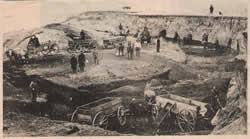Coal Mine Lake
|
||
Coal Mine Lake has always held a fascination for me. The name itself is so different, but back in the early days they named lakes and streams because of their color or shape or because of their surroundings. Coal Mine Lake was named because of a coal vein that was found there. Farmers who settled in that area of the Sheyenne River Valley in the very early years dammed a creek at the source of the Sheyenne to control flooding and to provide a more stable water supply for their cattle. The dam, made of sandbags, created a lake almost four miles long, a half-mile wide and 16 feet deep in some places. In the beginning, the biggest attraction to the lake was the discovery of rich deposits of coal along its banks. Back in the early years, farmers in that area would travel to the lake, where they mined the coal, digging it out with pick-axes and shovels. When their wagon were full of coal, the team of horses pulled the wagons to their farms, thus providing the farmer and his family fuel for the long harsh North Dakota winters. I believe that ended in the late 1930s. The temporary dam was replaced when in the 1930s, the Civil Conservation Corps built a more permanent dam. The CCC was an agency authorized by the United States government to hire unemployed young men for public conservation work in the drought stricken years of the 1930s. Building dams was one of their projects, besides planting trees. Later, Coal Mine Lake (also known as Sheyenne Lake) became a very popular recreation spot for people in the surrounding area. In the mid-thirties, people began to build cabins near and around Coal Mine Lake. Dr. Hammargren, of Harvey, was the first to build a cabin on the south shore of the lake. People have told me that at one time, there were 25 or more cabins out there. Back in 1960, they even had hot dog and hamburger stands out there for the weekend fishermen and the swimmers. Mrs. Hammergren, during an interview in the early 80s stated that it was so pleasant to go out to the cabin just to relax and get away from the phone-sort of get away from it all and enjoy the lake. She said her sister, Mrs. Bentz, had stored enough food out there for them to stay over the whole summer. There is a beautiful stand of trees near the campgrounds. Mrs. Hammargren said the trees were all planted by hand way back then. The Hammargrens and the Bentzes even hauled in sand so they could build a beach along the water near their cabins! At that same interview years ago, Mrs. Hammargren said another escape from the busy hospital and phone was in the fall when the men went hunting and would spend a few days out at their cabins. From what I read in the paper, the women were pretty good at handling the guns too. People from Anamoose, Harvey, Goodrich, Martin, and McClusky spent a lot of weekends out at the lake fishing, picnicking and swimming. Many a 4 th of July was spent out there. They had fireworks that looked quite spectacular exploding and cascading over the water in the evenings. It has been hard for me to understand the arrangement out at Coal Mine Lake. The water is owned by the federal government, but the land that surrounds it is manage by the state of North Dakota. The land owned by the U.S. fish and Wildlife Service ( Coal Mine Lake) is about 305 acres. The refuge, which extends to the east is about 212 acres around the marshland, and this is managed by the North Dakota Game and Fish Department. In the spring, there is fishing at the lake. The way I hear, some pretty big fish have been caught out there, but then, can I really believe all those fishermen? I don’t know, but I was told by the man named David Potter that in the fall, the area around and within the lake becomes part of a rest area for ducks, geese, and other wildlife. It is a sanctuary for waterfowl, with no hunting allowed there. The waterfowl need that area to rest, and feed before they make that long migration flight south for the winter. With all the rainfall in the past two or three years, the lake has plenty of water today, but there have been times in the past when one could walk across the lakebed. The U.S. Fish and Wildlife Service and the North Dakota Game and Fish Department work together as a team to see that the wildlife in the area does indeed have refuge at the lake. I wonder what some of the early settlers and cabin builders would say if they could see how tall the trees have gotten through the years, or how many big fish have been pulled out of Coal Mine Lake. It has such a shaky beginning, yet the settlers prevailed. I can only envy their strength and vitality.
|
